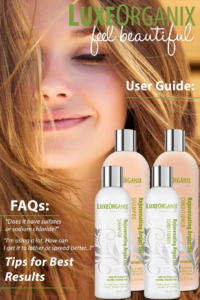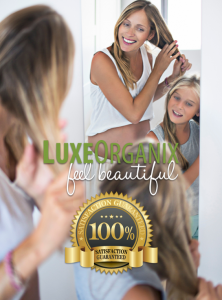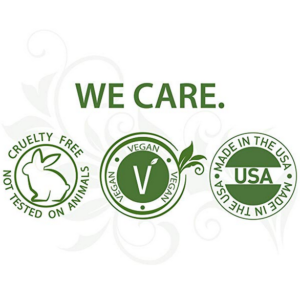
Thank you for your interest in LuxeOrganix Invigorate Shampoo and Conditioner. It is our sincere desire that you will absolutely love your hair and love your experience when you use our products.
Because we weren’t willing to settle for less than the best ingredients, with health as our priority, you may notice some differences between what you’ve used in the past, as you begin using our products.
Our goal is for you to have beautiful hair, without sacrificing your health. So let’s focus on what you can expect with LuxeOrganix, and how you can get your best, beautiful results with it.
– Christine Kominiak,
Founder of LuxeOrganix
Understanding and Maximizing Your Results With Your New Sulfate-Free Shampoo
Contents
Frequently asked questions
- Does it contain sulfates?
- I wish the shampoo had more lather.
- Where can I find an ingredients list?
- Why does my hair feel dry?
Get the same results without using more product than necessary
Applying the Shampoo
Applying the Conditioner
Using Styling Products with your Sulfate-Free Shampoo
How To Rejuvenate and Protect Your Hair
Recommended products
Need help?
Frequently Asked Questions
Here are some questions or requests we’ve received from our customers:
“Does it contain sulfates?”
No. LuxeOrganix Argan Oil Shampoo and Conditioner are 100% free from sulfates. Some ingredients may cause confusion over this because they have similar names that lead to the assumption that there are sulfates, such as:Sodium Lauryl Sulfoacetate (SLSA) – though Sodium Laurel Sulfate (SLS) and SLSA look and sound very similar, they are not the same. SLSA is a natural alternative to SLS. It is derived from coconut and palm oils, and conforms to Ecocert’s natural and organic cosmetic standard and is 100% of natural origin.
Disodium Laureth Sulfosuccinate (DLS)
This is not the same thing as Sodium Lauryl Sulfate or any other Sulfate surfactant. Sulfates are irritating in part because they’re small molecules that can penetrate and irritate the skin. DLS is a larger molecule that can’t penetrate skin. It belongs to a category known as anionic surfactants, meaning that it has a negative charge. The safety and mildness of DLS lies in the absence of a sulfate ion head, which is commonly found in many other surfactants. The sulfate ion, which originates in sulfuric acid, is replaced with the more stable and safer sulfonated ester. The result is an effective yet safe product that offers a plethora of advantages over sulfate chemicals. It’s considered very gentle on the skin, and is even suitable for more sensitive skin types. It’s manufactured as an added gentle foaming agent, which helps to create a lathering effect (since we don’t use sulfates that would otherwise help the shampoo lather).
While DLS has gentler properties than SLS, studies have shown that it can potentially irritate the skin in some people. There is no such thing that is not irritating to everyone, as our bodies are unique. Even 100% organic compounds (such as peanut oil or grape seed oil) can cause reactions in some people.
What’s important to note here is that DLS cannot penetrate the hair or skin. It does not affect keratin treatments, for example, because it only removes surface oil, which would be outside the keratin.
Sodium Lauroyl Sarcosinate is a natural product, made from coconut oil, and is derived from sarcosine, a natural amino acid found in the human body and just about every type of biological material from animals to plants. They may have the same initials (SLS), but sodium lauroyl sarcosinate and sodium lauryl sulfate are NOT the same thing. Sodium lauroyl sarcosinate is only similar to sodium lauryl sulfate in that they’re both surfactants, but that’s about where it ends.
A comprehensive safety assessment published in the International Journal of Toxicology deemed that sodium lauroyl sarcosinate was not expected to be potentially toxic or harmful, and had no mutagenic, irritating, or sensitizing effects.
We chose Sodium Lauroyl Sarcosinate because it is very mild, but also very effective. What’s more, it’s included in the Handbook of Green Chemicalsand is also Whole Foods Premium Body Careapproved — two stamps of approval that validate our confidence in the safety and sustainability of this ingredient. For more about ingredients,click here.
“I wish the shampoo had more lather.”
First, it’s important that you are aware that sulfate-free shampoos do not foam or lather up like other sulfate-based shampoos that can be harsh on hair and scalps, and cause health issues. Since LuxeOrganix is a sulfate-free shampoo (which means it will not lather the same as shampoos containing sulfates), hair type and length make a big difference when it comes to how much product is needed, as well as how it is used to get beautiful results.
As you know, using products with sulfates can cause a lot of problems for people, such as itchy, flaky and irritated scalps. It can be a little strange at first if this is your first experience using a sulfate-free shampoo, but just because it doesn’t have a lot of suds, doesn’t mean it isn’t cleansing your hair. We have been conditioned to associate suds with cleanliness, so it can take some getting used to (and trusting) that your sulfate-free shampoo is doing the job. (I know it was an adjustment for me!)
“Where can I find an ingredients list?”
You can find a complete list of ingredients, including additional details about each, by clicking here.
“Why does my hair feel dry?”
Though this is certainly more rare than what is normal for our customers, since our Argan Oil Shampoo and Conditioner set were designed to moisturize and soften hair, we have had a few customers with this concern.We have come across several possibilities of why someone may feel their hair is dry after using the shampoo, but let’s first look at the most likely reason, which is how the shampoo is designed.
LuxeOrganix Argan oil shampoo was designed to be a healthy alternative to salon quality products (as well as free from harsh and unnecessary extra ingredients that can cause many issues). It is not loaded up with extra moisturizers (or parabens), which can be found in lower quality, sulfate-based shampoos that strip hair of it’s natural, beneficial oils. These extra moisturizers or parabens give the impression of your hair feeling soft after washing with shampoo. So since LuxeOrganix doesn’t contain anything unnecessary, as mentioned above, this could be why for some, after rinsing out the shampoo, may feel their hair is dry; however, it should only be a reflection of your hair being squeaky clean, and is now prepared to be deeply moisturized and protected by the ingredients included in the conditioner.
Simply put – it’s designed not to be a stand alone product, but instead to be paired with the LuxeOrganix Argan Oil Conditioner.
Get the same results without using more product than necessary.
Applying the Shampoo
Before adding the shampoo, you first want to make sure you’ve rinsed your hair reallywell. Consider how your hair stylist rinses your hair, and even uses their fingertips to massage and scrub the scalp to get the extra sediment out and dead skin cells removed, before applying the shampoo.
Now, after your thorough rinse, spread the shampoo across your palms. Add a splash of water to your hair and then apply the shampoo to your roots. Use your palms to rub the shampoo around, and then use your fingertips to scrub and spread evenly. This will help the gentle sulfate-free cleansing agents lather up a bit and evenly spread.
If you’re still not getting the shampoo to spread or are not feeling any lather, try adding a splash of water.Then when rinsing the shampoo from your hair, alternate from using the fingertip scrubbing technique to get the product and any remaining sediment rinsed out, to squeezing from your roots to your ends.
Once you have rinsed thoroughly, your hair texture should feel squeaky clean (not moisturized or even soft necessarily), because our shampoo doesn’t contain parabens or other unnecessary conditioning ingredients. The conditioning is to be done by the conditioner, and by having the hair be squeaky clean, it will be better prepared to soak up the conditioning ingredients.
Applying the Conditioner
After rinsing out the shampoo, apply a dollop of conditioner to your hair and scalp. (For some people it is necessary to avoid adding the conditioner to the roots, as their hair/scalp type can tend to be oily and will cause the hair to lay down or become greasy-looking sooner. In this case, simply focus applying the conditioner to the hair alone.) Using a comb can also be helpful to spread the conditioner down to the ends of your hair, as well as detangle. Take a few minutes to massage it thoroughly into your hair and leave it on to soak for the remainder of your shower. (If your hair is typically dry, you’ll get more benefit from leaving it 5-10 minutes, vs. the standard 3-4 minutes that are suggested on the bottle instructions).
Using Styling Products with your Sulfate-Free Shampoo
It’s good to know that if you use styling products (such as gels, mousse, hair cream, hairspray, etc), and/or are not washing for several days, when using any kind of sulfate-free shampoo, you’re likely to have more build up, resulting in your hair or scalp appearing unclean (i.e. greasy/oily, flaky) or by feeling dry or itching.
Since sulfates are known for stripping the hair, they are able to handle lots of product build up or several days of not washing. So using a sulfate-free shampoo is a bit of a trade off: no sulfates means that you’re working with a gentler product that may require a little extra effort (i.e. adding water to get it to spread better), or even a little extra shampoo to remove build up – vs – a sulfate based shampoo is more harsh on your hair/scalp and contains ingredients that are linked to numerous scalp, skin and health conditions.Being sure to rinse and scrub well, like a professional stylist does when shampooing your hair, along with leaving the shampoo on for just a minute or two to soak, before rinsing, can give the cleansing agents a chance to work at removing extra sediment.
However, another common reason for hair feeling dry after washing it with the shampoo, is that the hair is already severely dehydrated or even damaged. Many of our customers have found it helpful that after washing with the shampoo and conditioner, following with a small amount of LuxeOrganix Argan Oil Styling Cream helps add hydration and control, leaving hair smooth and frizz free, and adding manageability.
Also helpful is to occasionally use a deep conditioning hair mask, in place of the Argan Oil Conditioner. TheLuxeOrganix Deep Conditioner Hair Maskis designed to pair perfectly with the Argan Oil Shampoo, and can make a significant difference in the health of your hair and scalp.
If you’re frustrated with dry scalp or hair, and want to give it something nourishing, you can’t beat the premium ingredients that are in this hair mask. You will notice almost immediately how it penetrates deeply, to strengthen, repair and grow healthy hair.Of course using high quality products meant for your specific hair type is only part of the equation.
Taking good care of your hair, eating healthy foods that will enable your hair to grow healthier, and using simple home remedies can help treat and restore dry hair to being naturally beautiful.




